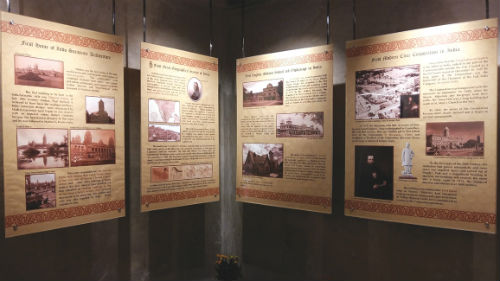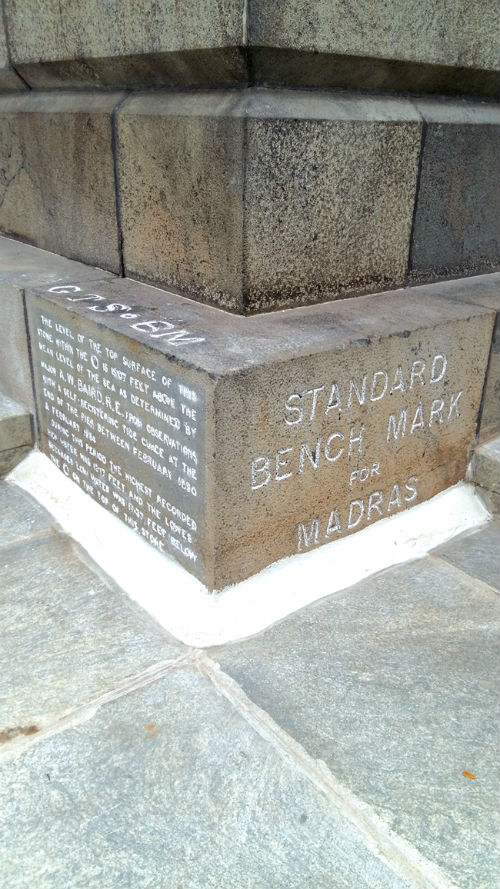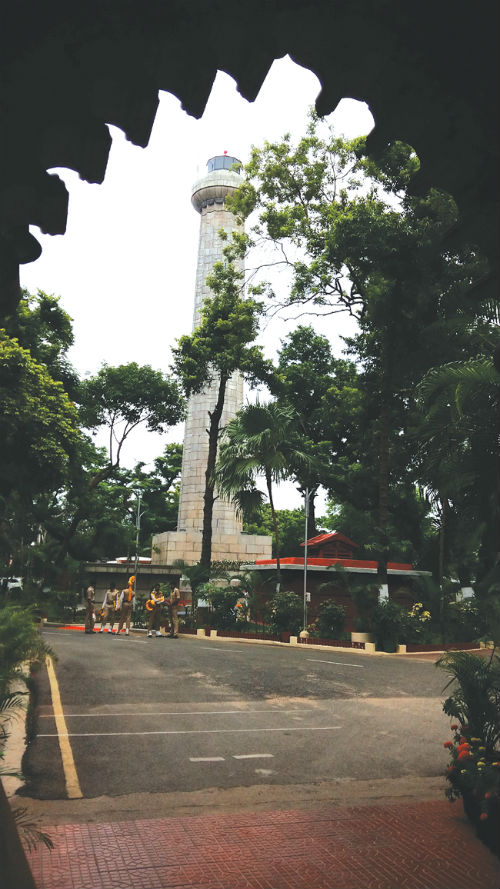Registered with the Registrar of Newspapers for India under R.N.I 53640/91
Vol. XXVII No. 13, October 16-31, 2017
Pillar ‘lighthouse’ now restored
by Geeta Padmanabhan

The ‘Madras First’ exhibition in the Pillar Lighthouse.
On the night of June 1, 1894, mariners streaming into Madras Port could see their guiding light beaming from a structure taller than the earlier one. Their complaint that the High Court building surrounding the lighthouse distracted navigation in and out of the Port had been addressed. The light now flashed from the court’s tallest dome.
With the new lighthouse on the campus, the Doric pillar one fell on bad days. The lighthouse might have ceased to guide the ships, but heritage aficionados have now decided to guide people to its historicity. “The idea of restoring the lighthouse was mooted by the Heritage Committee of the High Court, of which I am a member,” said well-known lawyer N.L. Rajah. “We also decided to establish [in the old store-room] photographic exhibitions on two topics – ‘Madras the First City of Modern India’ and ‘The Contribution of Legal Professionals of Madras Presidency to Public Life’. Funds for renovation would come from the Rs.17.5 crore sanctioned by the Government of Tamil Nadu for heritage conservation work in the courts and from the grants for courts from the five-year-plans of the Central Government.” The emphasis was on making no modification to the original structure.

The standard bench mark at the base of the Pillar Lighthouse.
In 2013 the public was informed of the plan to carry out restoration of the lighthouse. The State PWD and the Archaeology Department were brought in. The PWD requested the National Centre for Safety of Heritage Structures – IIT-M for a technical report on the areas of decay and suggestions for restoration. Dr. Arun Menon and Prof. S.R. Gandhi submitted the NCSHS report in February 2016.
“We were guided by the heritage committee and ASI,” said PWD officials, describing the restoration work. By injecting “appropriate chemicals”, they removed the tree-roots around and inside the foundation wall. Cracks in the foundation wall were filled with rich lime mortar. To protect the foundation chamber from future breach by roots, the brick-masonry wall was given a coat of traditional lime-plaster.
Dislodged stones in the sunshade of the four chambers were reset as per original design. Broken stones were mended with mild steel and reset in their places. Missing stones were replaced with ones matching the original.
“The roof treatment was a challenge, but we carried it out successfully,” said PWD. All four chambers got a Madras terrace roof, and wooden beams and joists have been polished and restored to their original state. The surface stones on the exterior were chemically cleaned and lead-pointing provided where needed. Floors in the chambers and the internal pathways have been laid with stone slabs.

The Doric Pillar Lighthouse after renovation.
The lighthouse column was washed with chemicals. Wood-framed wire-mesh has been fixed to the small openings to keep birds/bats out. Dislodged stones on the summit have been reset. A stone apron has been built around the base of the structure to prevent water percolation into the foundation. Staircases have been repaired and railing has been provided. The interior walls of the entire column have been coated with lime plaster. Perhaps the most significant part of the restoration is the revival of the lantern room. According to British Library records, the lantern-room consisted of “a 12-sided polygon framed in gun-metal with 9 glasses and 3 blank faces. The interior diameter of the lantern is 9 feet and its height, 4½ feet. The entrance is on the west side. On the pedestal is inscribed 1838-1844. There are 210 steps (now 197) to the light, including 3 on the short wooden ladder. The 15 burners were maintained by 6 light-keepers.”
Alas, no one knows when the lantern room was dismantled and where the lighting equipment has gone. So, “when the matter was discussed in the committee, I volunteered to make a new one,” said D. Venkataraman, Director, Directorate of Lighthouses & Lightships. D.H. Rao was consulted on the correct design to match the original and his design was adopted. “The lighthouse no longer throws light, but the lantern-house gives it life,” said Venkataraman.
This (second) lighthouse is unique in being the only one to be standing inside High Court premises. Its restoration is a matter of joy for all. When the Court gives permission, do visit it for a slice of Chennai’s maritime past. Go around the base to check-out the inscription in the corner regarding the survey point of the Great Trigonometrical Survey of India and the stone that stands for the “Standard Benchmark of Madras”. Go through the exhibition in the wonderfully restored store-room with skylights. Go up the lighthouse for a view of Chennai. You cannot get a better place to savour the convergence of the past and present of Chennai’s coastal history. The restoration group plans to install information boards and seating arrangement and provide people with binoculars.
(To be concluded)

